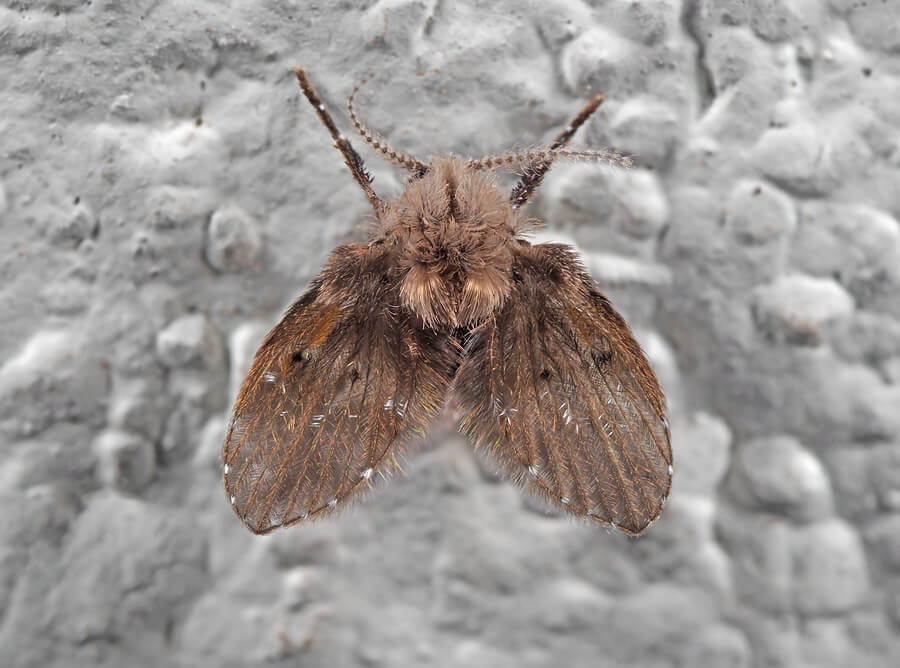Keep drains clean– Both kitchen and bathroom drains can provide ideal locations for fruit flies to lay their eggs. There are two DIY methods of drain cleaning that come recommended for fruit fly prevention. One is to flush drains with boiling water and use a metal pipe brush available at many hardware supplies and then flush once again with more boiling water. This helps remove any particles that might be clinging to the pipe walls and providing a ready food source. The second method is to pour a mixture of, half a cup of salt, half a cup of baking soda and a cup of apple cider vinegar into the drain and let it sit overnight. One of the simplest is to combine ½ a cup of salt with ½ a cup of baking soda and pour it into the drain.
Then add a cup of vinegar and let it sit overnight. Larger doses can be used for bigger pipes but the proportions should remain the same. The next morning flush well with the hottest water available. The foaming action of the vinegar and baking soda along with the natural cleansing of the salt will loosen built-up grime and give off carbon dioxide to help smother young fruit flies. You may also want to double-check that your pests in question aren't drain flies, which lurk around drains or garbage disposals, or fungus gnats, which prefer overwatered houseplants.
For those critters, you'll want to check out our guide for how to get rid of gnats. Fruit flies usually appear light or dark brown in color with red eyes. If you're sure you've identified the critters correctly, then try one of these effective remedies to get rid of fruit flies in your kitchen. The other kitchen fruit fly solution is to trap them. There are several traps that you can construct on your own from readily available materials. The majority of these involve placing some form of bait in a bowl or glass.
The bait can be a piece of fruit, apple cider vinegar, yeast, and sugar dissolved in water, even old beer or red wine. You then cover the bowl or glass with plastic wrap and poke small, think toothpick size, holes in the plastic. The fruit flies can find the holes to enter by following the trail of the gases that the bait gives off. They become trapped and you can dispose of them as you see fit. Note that it is important to use clear containers and wrap when possible.
Fruit flies don't like dark places so these traps aren't as effective if the interior of the trap is dim. Most of the fruit flies in my home are coming from the kitchen and bathroom sink drains. I've used commercial (non-toxic) traps to catch the ones that have already hatched. To stop the eggs from hatching in the drains, I pour baking soda and vinegar down the drain.
I let that sit for a few minutes and then pour boiling water down the drain. Once that it done, I keep the drains closed to stop the ones that aren't killed from being able to fly out. "Fly identification is the critical first step in the control process," affirms Fredericks. And don't forget to wipe up spills as soon as they happen, since it doesn't take much to attract and sustain fruit fly development, he adds.
If you're looking to get rid of fruit flies, you might be wondering how you got them in the first place. According to the experts at Orkin, fruit flies are attracted to ripe, rotting, or decayed fruit and produce, as well as fermented goods like beer, liquor, and wine. They can also inhabit trash cans and garbage disposals if sufficient food is present. Female fruit flies lay about 500 eggs at a time, and the eggs hatch in as little as 24 hours. Obviously, that makes these critters almost impossible to control.
Once they have become established in drains it can be very difficult to eliminate fruit flies without the necessity of taking pipes apart. There are however several methods that aren't too intrusive but have shown some success. These are mainly different ways of flushing out the flies, their larvae, and eggs while at the same time cleaning the pipes and removing their food source. Many websites suggest pouring bleach or ammonia down the drain to kill the fruit flies and their young but experts almost unanimously disagree with this suggestion.
It may successfully drive out the adults but the larvae will burrow into the muck on the pipe walls and not be affected. Two days later they emerge as a fresh batch of adults and you will back to square one. How long fruit flies live is greatly dependent on the weather. They thrive in warm humid climates and tend to die out quicker in colder climates. Their minimum natural lifespan is 25 days but on average they will live for 40 to 50 days. What is truly amazing, is that in that short period of time a female can produce over 500 offspring and all of her female babies will be fertile and ready to breed in less than two weeks.
That is why it is so important to eliminate fruit flies when you first see the first signs of their presence. A single pair of mating Drosophila can flare into a full-blown infestation in the blink of an eye. If fruit flies do make your kitchen their hangout spot, there are ways to trap them.
They like fermented fruit, so mix a bit of dish soap with old beer, wine or apple cider vinegar. Pour water into the mixture until it bubbles, and leave the glass or bowl on the counter where you spot the flies. They'll come to the glass because of the fruit sugar, but get trapped in the soap bubbles. You can also fit plastic wrap over the top of a beer bottle or glass of vinegar, and poke a few holes in it. Besides cleaning regularly, the best thing you can do to prevent a drain fly infestation is to make sure that you do not have stagnant water sitting in your pipes.
Getting Rid Of Fruit Flies It can sit in the curves of rarely used pipes—like in that guest half bath that's almost never used. Ameliorating the effect of stagnant water is as simple as running the water in rarely used showers or drains for about a minute once a week. For good measure, add half a cup of salt and half a cup of baking soda to the drain and flush down with one cup of white vinegar.
People are usually a little shocked when they discover that they have fruit flies in their bathroom. All of these requirements are more than meet in the average bathroom. That is an ample food source for fruit flies to flourish. The question is how to destroy fruit flies in your bathroom before they drive you mad. Keep garbage disposals clean– Disposal units are a natural haven for fruit fly eggs and larvae to develop in.
They are generally always wet and a supply of food is constantly being delivered. Simply pour it full of ice add 1 cup of salt or vinegar and then run the disposal with the water running as you normally would. This scrubs out and food particles that might be stuck inside the disposal and as an added bonus will sharpen the blades of your disposal. Fruit flies are attracted to the smell of apple cider vinegar, white vinegar, wine or beer.
Setting out traps for fruit flies made from these solutions is a natural remedy for these pests. Fruit flies will fall or fly into these traps but then can't get out. You can buy traps that mimic these smells or make your own. Below are several different types of DIY fruit fly traps you can try.
Make several and set them out around the infested area. As we said, fruit flies are attracted to ripe, rotting fruits and vegetables. They may also breed around other fermented beverages, including wine, beer, or liquor, or even any place where there is a film of fermented organic material.
This is why swarms of flies are often seen hovering around a sink drain, garbage disposal, mop bucket, or even a damp sponge left out. Overripe produce is not the only place where fruit flies can lay their eggs, though. Look for small accumulations of sludge that fruit flies can utilize for laying eggs. This sludge is best described as a goopy solution of debris and liquid that collects in the bottom of trash cans, inside garbage disposals, inside plumbing and in the seams of appliances.
Even a small amount of sludge can host a few fruit fly eggs. A lot of people think they have fruit flies but fruit flies will usually be found infesting decaying fruits and vegetables and not as frequently in drains. Also, fruit flies will usually have red eyes which is a way to quickly distinguish them from drain flies. If those bananas or onions are starting to look iffy, it's time to toss them before they become a breeding ground for pests.
"Promptly discard any rotting food, as this is where fruit flies lay eggs — which can be up to 500 at a time," Wheeler says. That means you should also immediately take that garbage that's filled with rotting fruits and veggies outside and tie it up, too, instead of simply tossing it in your kitchen trash can. In addition to eating your ripe or rotting food, fruit flies need a place to live and reproduce.
This is especially true if you have a clog or plumbing issue. It's particularly dark and dank when the sink is stopped up. Once the larvae hatch, they do the same thing as their parents - they eat your food and infest your kitchen.
At some point in time when the drain won't be disturbed for several hours, combine ½ a cup of salt with ½ a cup of baking soda and pour it into the drain. Follow this with 1 cup of white vinegar and let it sit; preferably for 6-10 hours. Then pour several cups of boiling water down the drain. The foaming action of the vinegar and baking soda mixing helps to scrub the gunk out of the pipes and gives off carbon dioxide gas preventing the fruit flies from being able to breathe.
The boiling water flushes the lines clear and helps remove any remaining grease. Keep the kitchen clean and dry– Not to be insulting but most kitchens aren't as clean as people think they are. Making the deep cleaning and sanitizing of all kitchen spaces a regular routine goes a long way towards avoiding fruit fly invasions. When possible, move all appliances and furnishings and clean ceiling to floor and from walls to the center of the room. You can also remove fruit flies by regularly cleaning your drains with boiling water or with a boiling vinegar .
Doing this will destroy the growing larvae of the fruit flies inside your drain pipes. You may also use a drain snake to kill the fruit flies' larvae inside the pipe. Once cleaning is completed, cover the drain with a duct pipe for a whole day – this will ensure that remaining flies get stuck to the duct tape while trying to escape.
To make your own fruit fly trap, fill a shallow bowl with apple cider vinegar and cover it with a plastic wrap. The flies will be attracted to the sweet aroma and climb into the bowl, but they won't be able to come out of the trap. You can try a similar tactic with a bowl of water and a drop of dish soap. First, pour a pot of boiling water down the sink.
Then, make a solution by mixing one cup of vinegar and one cup of baking soda. Cover the drain with a drain plug for about 10 minutes. This should unclog the kitchen sink drain, making it a less attractive place for fruit flies to reside. It is sometimes difficult to find or recognize breeding sites because the fly larvae are tiny and easy to overlook. However, the adult flies can be detected by using a simple trap.
Another method is to tape over the drain with clear tape and see if flies can be found stuck to the tape. If these inspection methods are not productive, then expand the search. Aside from being a nuisance, fruit flies they have the potential to contaminate food with bacteria and other pathogens. To avoid a fruit fly infestation, store produce in air-tight containers or refrigerators and inspect any fruits or vegetables brought into the home.
Also, establish a schedule to regularly clean drain lines, garbage disposals and any location where food waste accumulates. Fruit flies often infest homes with ripe, rotting, or decayed fruit and produce. They also enjoy fermented items such as beer, liquor, and wine. Fruit flies also may breed and develop in drains, garbage disposals, trash cans, and mop buckets. Once they begin reproducing indoors, females are able to lay about 500 eggs and the eggs will hatch in as little as hours after being deposited by the female.
Those buzzing, pesky, little fruit flies are the last things you want to find in front of your face — especially when you're cooking dinner or sitting down to breakfast. And for such little pests, they sure prove a tough challenge to get rid of once they arrive. Fortunately, there are simple and effective ways to get rid of fruit flies fast using natural fruit fly traps that you can DIY at home. With some strategic cleaning and a few household supplies, you can stop these irksome insects in their tracks.
Pour one cup of vinegar down the drain and let it sit for several hours then flush with boiling water. This is best used as a preventive measure as it works by speeding up the decaying process of any food particles trapped in the drain denying the fruit flies a food source. With repeated treatments over several days though, it has been found to reduce the fruit fly population. When you spot any insect inside your house, it's best to take action immediately before they get a chance to multiply.
Just like pesky fruit flies, annoying gnats, and even fleas, drain flies are another common household insect that, well, bugs us. Measuring a teeny one-eighth of an inch, drain flies tend to congregate around standing water. Gray or taupe in color with small, rounded wings, they're also called moth flies, sewer flies, or filter flies. And contrary to what their name suggests, they don't actually "fly" as much as they hop from surface to surface. Drain flies surprisingly can live for up to three weeks, and new eggs can hatch every 48 hours or so. For these very reasons, you should act fast to eliminate drain flies for good using DIY home solutions or store-bought products.


















































